How intelligent design, behavioural insight and real-world testing led to a new standard in site safety
In today’s increasingly complex and high-pressure environments, securing spaces is no longer just about putting eyes on a site; the risks we face have evolved. Security is no longer a question of presence alone; it’s a question of performance, adaptability, and relevance.
At Optimum Group, we’ve spent the last 26 years in the field, not just securing sites, but observing how risks manifest, why offenders succeed, and what clients need to move forward with confidence. We’ve worked in active construction zones, industrial estates, high-crime hotspots, and remote utility locations. This has taught us one truth: traditional security is reactive, and reactive no longer works.
Our response wasn’t to build a better camera system. It was to reimagine what security could do, and what it should mean, in the modern world. From that pursuit, the Askari Tower was born.
Crime is smarter. So are we, putting intelligence before infrastructure
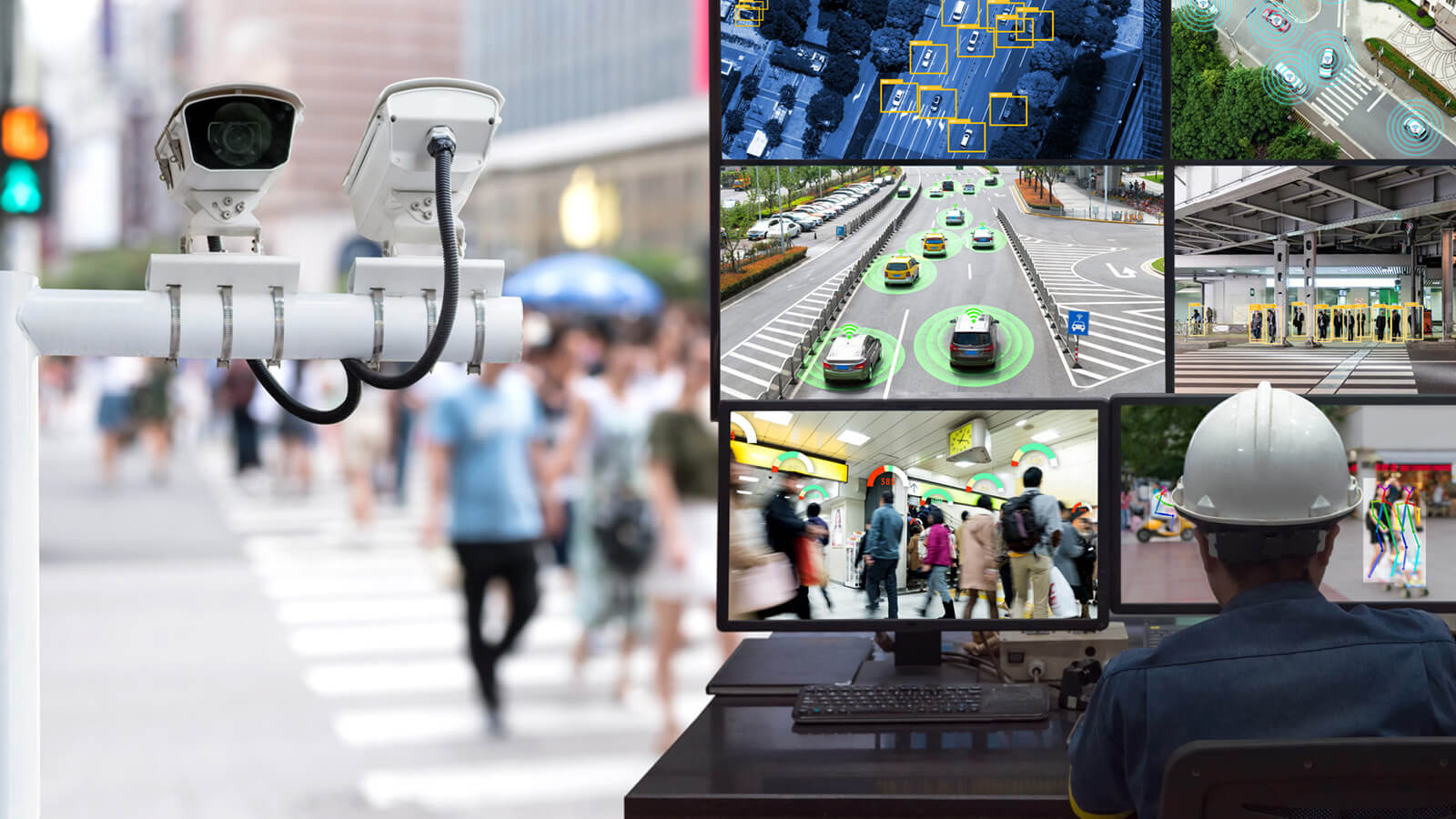
Security threats today are often as intelligent as the systems designed to stop them. Perpetrators study patterns, identify weaknesses in manual patrols or static systems, and exploit the blind spots created by over-reliance on outdated methods.
The first step in overcoming this was to move beyond the hardware itself. We examined offender psychology, criminal behaviour, and environmental influences. Why do certain hotspots attract repeat incidents? Why are some perimeter breaches never noticed until it’s too late? How do high-risk areas turn into normalised zones of vulnerability?
We found that many of these incidents were not simply a failure of surveillance, but a failure of design thinking, a lack of foresight into human behaviour, time-of-day patterns, site-specific risks, and the motivations that drive illegal action. Our goal became to model risk not by its outcome, but by its origin.
This shift demanded a new way of thinking, one grounded in criminology, behavioural analysis and operational psychology. We analysed not just what offenders do, but why they do it. We examined patterns: what attracts repeat incidents, what conditions make a site more vulnerable, and how timing, lighting, routines and perceived enforcement all play a role in enabling illegal or unsafe activity.
This allowed us to move beyond reactive solutions and toward predictive, adaptive deterrence. Our question changed from “how do we capture what happens?” to “how do we reduce the chance of it happening at all?”
We didn’t just build technology. We built insight into it.
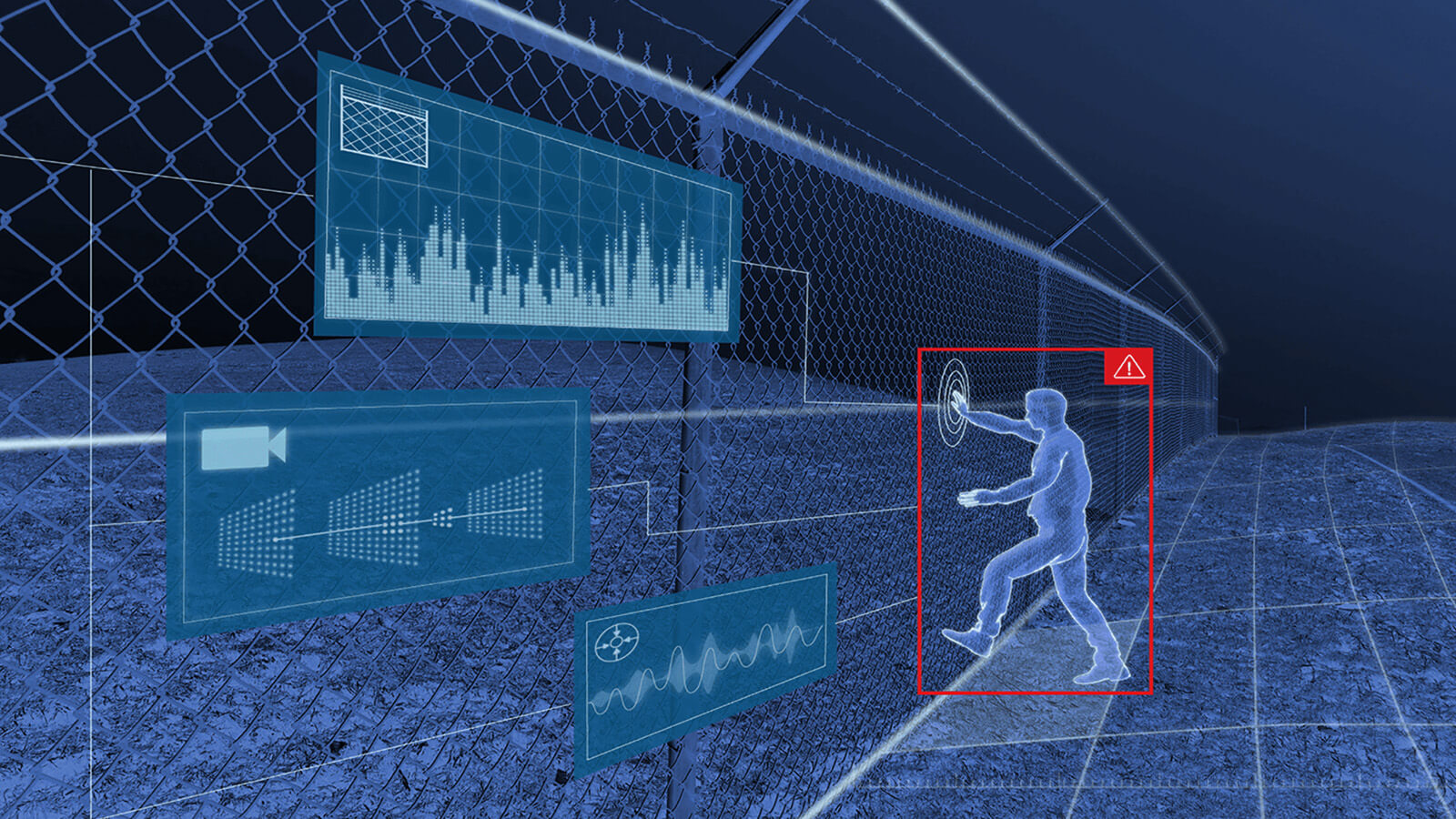
The Askari Tower reflects this thinking at every level, while at its surface, it is a rugged, self-powered surveillance platform, mobile, rapid-deployment, solar-ready. But beneath the hardware lies the real engine: an AI system designed to interpret behaviour, trigger action, and learn from interaction.
Rather than replacing human input, Askari was built to enhance it. Our analytics suite detects loitering, perimeter breaches, unauthorised entry, and unusual behaviour, not just logging activity, but classifying it in context. This means reduced false alarms, faster response, and more precise deployment of resources.
Every deployment is a learning experience. We use real-time data, video review, and performance benchmarking to continually update our predictive models. That data also belongs to our clients, useful for internal audits, claims defence, or stakeholder reporting.
But where Askari truly separates itself is in how it thinks beyond security.
From the outset, it was never intended to be a standalone security unit. It was developed as a platform: one that supports multiple functions across risk management, operational oversight, and environmental responsibility, all while remaining completely self-sufficient and rapidly deployable.
Designed around the way you work
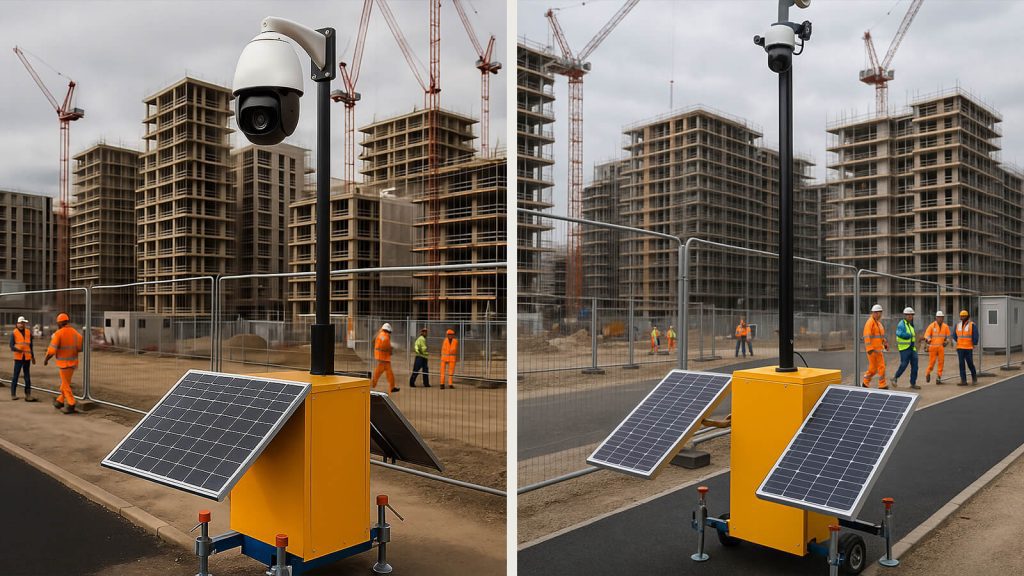
When designing Askari, we didn’t ask what features should be included. We asked what decisions our clients were trying to make, what risks they were trying to reduce, and what goals they were trying to meet.
On a construction site, this might mean tracking site entry and plant movement, managing environmental KPIs, or demonstrating ISO 14001 compliance. For a council, it could mean deterring fly-tipping while also monitoring waste-related CO₂ emissions, reducing the need for fuel-heavy clean-up fleets, and engaging with community safety expectations. For a gated community, it’s about safety, transparency, and visitor accountability, and maybe even a digital notice board or parcel delivery station built into the tower.
Our system integrates with:
- Access control gates, for seamless entry monitoring
- ANPR systems, to log vehicle entry and exit
- CO₂ tracking, correlating vehicle traffic with emission reporting
- Time-lapse capture, not only for security but also for progress documentation and marketing use
- Cloud-based dashboards, where management teams can view real-time analytics and footage from anywhere in the world
Next, we addressed the operational pain points:
- No trenching, cabling or diesel dependency. Each unit is solar-powered with a battery or hybrid system, meaning it can be deployed in hours and remain fully off-grid.
- Rapid repositioning as the environment evolves. Unlike permanent installations, Askari adapts without disruption or infrastructure downtime.
- Tamper-resistant housing and elevated masts offer high visibility while withstanding weather, vandalism or attempted interference.
Finally, we incorporated long-term resilience:
- Every tower is built to support ongoing adaptation. It feeds data into wider systems, from access control to risk dashboards to site compliance reports. As the data is clean and structured, it becomes an asset far beyond its surveillance purpose.
Security as a strategic tool
Too often, security is positioned as a necessary cost. When designed correctly, it can be an operational multiplier, reducing downtime, improving compliance, cutting overheads, and contributing to broader organisational goals.
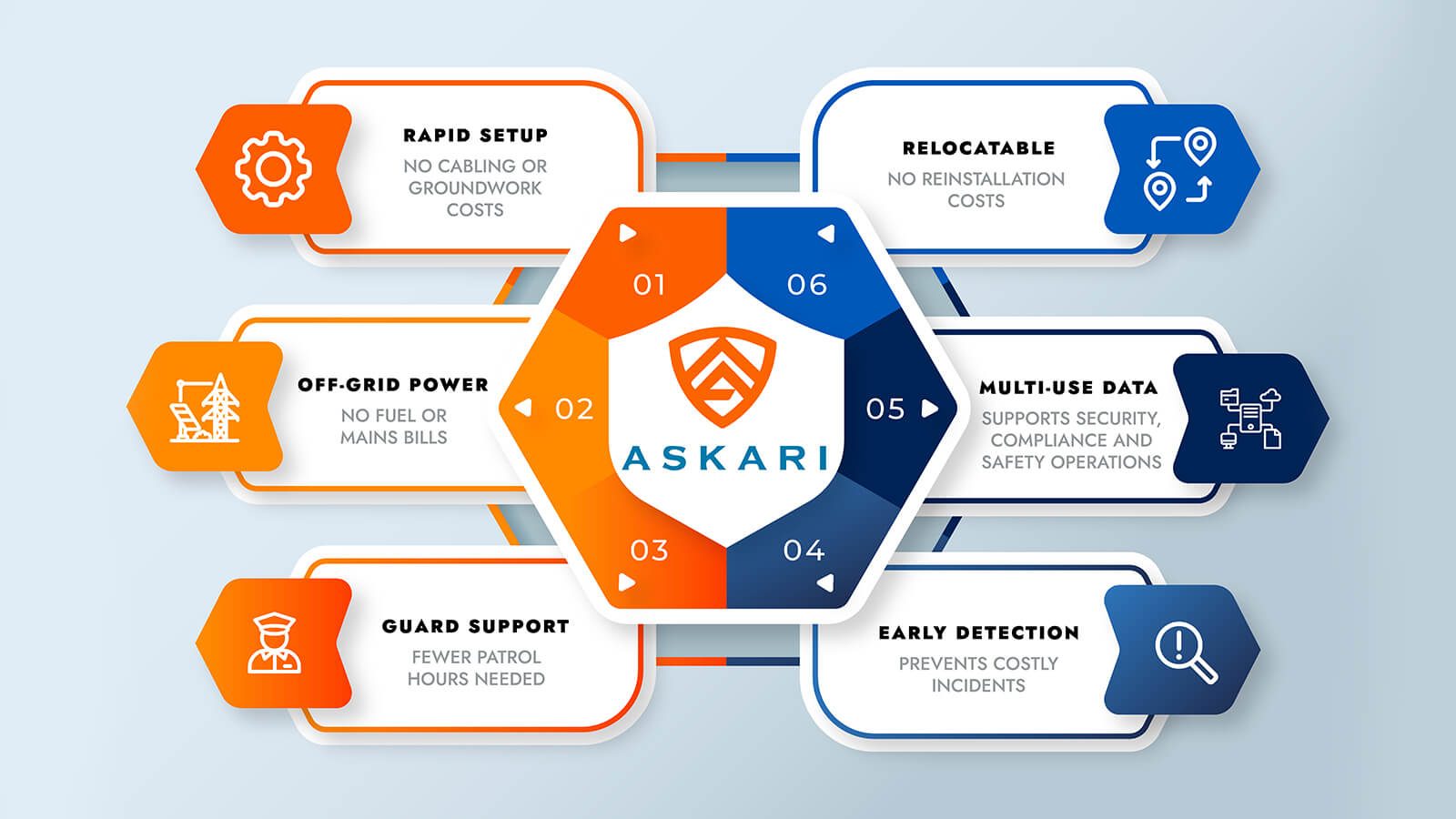
For those managing large, sensitive or remote environments, this is critical. Consider:
- The amount of fuel and labour required to patrol expansive zones daily
- The cost and risk exposure associated with manual gatekeeping or underreported access
- The challenges of maintaining continuity during early-stage setup, shutdowns, or phases of high staff turnover
- The inefficiencies of unstructured footage and incomplete incident logging when an event does occur
Askari was developed to resolve these friction points. It is more than a camera pole; it’s a connected hub. It provides not only security, but:
- Instant, verifiable evidence in the case of claims or disputes
- A measurable contribution to sustainability goals by reducing reliance on generators and vehicles
- Enhanced duty-of-care monitoring, especially in environments where personnel work alone or at unconventional hours
- Data streams that support compliance reporting, performance benchmarking, and strategic planning
By building Askari with these outputs in mind, we created a system that doesn’t just record value, it delivers it, daily.
From mission-critical to community-based: A system that serves all sectors
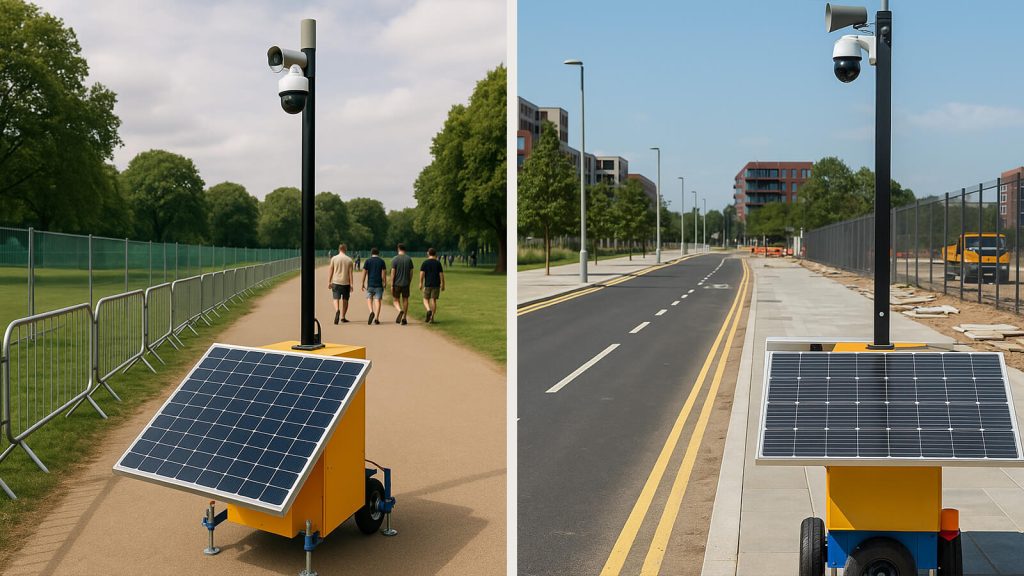
One of the most important lessons we’ve learned is that no two sites are the same, but the need for reliable intelligence is universal.
- For councils: Askari enables waste monitoring in high-dumping areas, reduces the cost of clean-up operations, and offers accountability via high-resolution footage and licence plate logs. It helps to quantify the environmental benefit of reduced vehicle deployment, and gives local authorities data to support policy, enforcement and grant applications.
- For construction and infrastructure: Projects are protected from theft, intrusion and health and safety breaches. Askari supports CDM compliance, ensures duty of care to lone workers, and provides footage that can be used to resolve insurance claims or disputes with contractors.
- For residential developments: Askari acts as a transparent, always-on guardian, deterring unwanted activity, managing visitor logs, and even acting as a communications or logistics node. It’s not just about protection, it’s about peace of mind and community visibility.
- For mission-critical installations: Whether deployed at utility sites, renewable energy farms, or temporary substations, Askari provides self-sufficient surveillance where uptime is non-negotiable. This is risk mitigation at its highest standard, without the cost of permanent infrastructure.
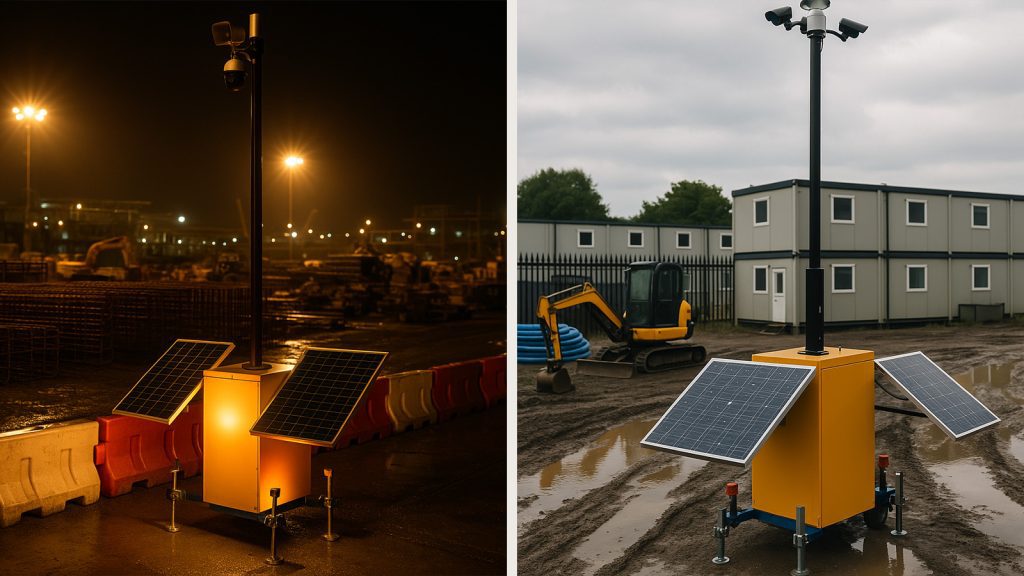
Seeing the bigger picture: Security as a strategic advantage
Where others may see a tower, our clients see a decision-making tool. One that reduces blind spots, eliminates inefficiencies, and captures insight across safety, environmental performance, and site operations. It helps organisations not only react to risk, but to plan around it, measure it, and report on it with clarity.
More than anything, Askari is proof that security can evolve, and that it must. The risks our clients face are no longer passive. They are intelligent, complex and multidimensional. Our response must be the same.
So, we embedded criminology. We modelled behaviour. We forecasted threats. We collaborated across sectors and built something that would not just keep up with modern demands but help define them.
Interested in deploying Askari at your site, organisation or community?
Please get in touch for a tailored walk-through of what’s possible and how to get started.
